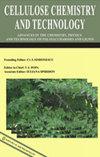INVESTIGATING THE EFFECT OF MICROWAVE IRRADIATION TIME, POLYETHYLENE GLYCOL CONCENTRATION AND pH ON THE PROPERTIES OF Mg-BASED BACTERIAL CELLULOSE NANOBIOCOMPOSITE
IF 1.1
4区 农林科学
Q2 MATERIALS SCIENCE, PAPER & WOOD
Cellulose Chemistry and Technology
Pub Date : 2023-07-20
DOI:10.35812/cellulosechemtechnol.2023.57.52
引用次数: 0
Abstract
Mg-based bacterial cellulose nanobiocomposites (Mg-BCN) were produced assisted by microwave irradiation. In this study, the effects of the concentration of starter molecules, solution pH, and microwave irradiation time (MIT) on the properties of Mg-BCN were investigated. Tensile strength, structural properties, morphology and thermal stability of the nanocomposites were evaluated. According to the obtained results, an increase in the concentration ratio of starter molecules, pH, and MIT increased the formation of MgO, in comparison with Mg(OH)2. The nanocomposites synthesized with the 1:2 and 2:1 concentration ratio of magnesium acetate to polyethylene glycol, at pH 11 and with 3 minutes of MIT, had the largest tensile strength and crystallinity. Meanwhile, the opposite results were obtained with 1:1 and 1:0 ratios, at the mentioned pH and time. According to FESEM analysis, at pH = 9, the nucleation rate decreased and smaller particles were formed. Moreover, the results showed decreased possibility of agglomeration in the presence of polyethylene glycol (PEG). TGA results indicated that the thermal stability of all Mg-based nanocomposites is higher than that of pure cellulose. In addition, the maximum weight loss temperature in all treatments involving PEG was higher than in the case of the samples treated without PEG.微波辐照时间、聚乙二醇浓度和pH对镁基细菌纤维素纳米复合材料性能影响的研究
微波辅助制备了镁基细菌纤维素纳米复合材料(Mg-BCN)。研究了发酵剂浓度、溶液pH和微波辐照时间对Mg-BCN性能的影响。对纳米复合材料的拉伸强度、结构性能、形貌和热稳定性进行了评价。结果表明,与Mg(OH)2相比,增加发酵剂分子的浓度比、pH和MIT都增加了MgO的形成。当乙酸镁与聚乙二醇的浓度分别为1:2和2:1、pH为11、MIT时间为3 min时,合成的纳米复合材料的抗拉强度和结晶度最大。同时,在相同的pH和时间下,1:1和1:0的比例得到相反的结果。FESEM分析表明,pH = 9时,成核速率降低,形成较小的颗粒。此外,结果表明,聚乙二醇(PEG)的存在降低了团聚的可能性。TGA结果表明,所有镁基纳米复合材料的热稳定性都高于纯纤维素。此外,所有涉及PEG处理的样品的最大失重温度都高于未涉及PEG处理的样品。
本文章由计算机程序翻译,如有差异,请以英文原文为准。
求助全文
约1分钟内获得全文
求助全文
来源期刊

Cellulose Chemistry and Technology
工程技术-材料科学:纸与木材
CiteScore
2.30
自引率
23.10%
发文量
81
审稿时长
7.3 months
期刊介绍:
Cellulose Chemistry and Technology covers the study and exploitation of the industrial applications of carbohydrate polymers in areas such as food, textiles, paper, wood, adhesives, pharmaceuticals, oil field applications and industrial chemistry.
Topics include:
• studies of structure and properties
• biological and industrial development
• analytical methods
• chemical and microbiological modifications
• interactions with other materials
 求助内容:
求助内容: 应助结果提醒方式:
应助结果提醒方式:


